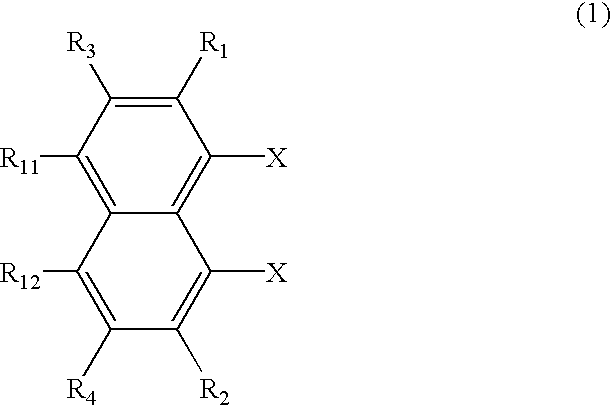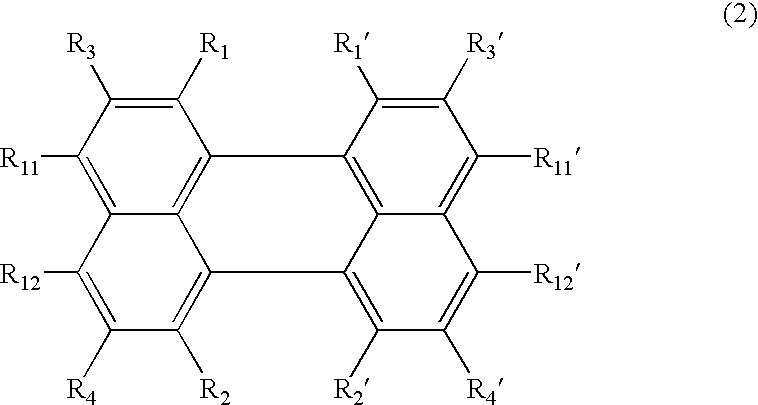Perylene derivative synthesis process, perylene derivative and organic EL device
a technology of perylene derivative and organic el, which is applied in the field of organic el devices, can solve the problems of limiting the degree of freedom of compound design, low preparation efficiency, and low efficiency of prior art synthesis procedures
- Summary
- Abstract
- Description
- Claims
- Application Information
AI Technical Summary
Benefits of technology
Problems solved by technology
Method used
Image
Examples
example 1
Synthesis of 1-o-biphenylyl-3-phenylisobenzofuran
[0195] In Ar, 3.9 g (1.68E-2 mol) of o-bromobiphenyl was dissolved in 30 cm.sup.3 of tetrahydrofuran (THF) at -50.degree. C. To the solution was added 10 cm.sup.3 of a nBuLi hexane solution (1.5 mol / l). After 2 hours, 3 g (1.4E-2 mol) of 3-phenylphthalide was added to the solution while it was kept cooled at -50.degree. C. After 2 hours, the reaction solution was allowed to resume room temperature, and 10 cm.sup.3 of a 35% aqueous hydrochloric acid was added thereto. After 1 hour, toluene extraction was carried out using a separatory funnel, followed by thorough washing with distilled water. After the toluene solution was concentrated, the end product was isolated by silica gel chromatography (developer, toluene:hexane=1:4). There was obtained 4 g (80%) of a yellow viscous substance emitting bluish green fluorescence. 141
Synthesis of 3,4-dibromo-(7-o-biphenylyl-12-phenyl)-benzo[k]fluoranthene
[0196] In toluene, 2.2 g (6.45E-3 mol) of 1...
example 2
[0202] Synthesis of 3,4-dibromofluoranthene Derivative
[0203] A series of 5,6-dibromofluoranthene derivatives are obtainable by effecting Diels-Alder reaction between 5,6-dibromoacenaphthylene and a butadiene derivative and then effecting dehydrogenation reaction with dichiorodicyano-quinone (DDQ).
[0204] In xylene, 5 g (1.6E-2 mol) of 5,6-dibromoace-naphthylene and 3.3 g (1.6E-2 mol) of 2,3-diphenylbutadiene were heated under reflux for 48 hours, obtaining 5.6 g (70%) of an intermediate.
[0205] In toluene were dissolved 5 g (9.6E-3 mol) of the intermediate and 2.2 g (9.6E-3 mol) of dichiorodicyano-quinone (DDQ). By effecting reaction at 120.degree. C. for 24 hours, 3.0 g (60%) of 3,4-dibromo-8,9-diphenylfluoranthene was obtained. 144
Synthesis Route of dibenzotetraphenylperifuranthene via Suzuki Coupling
[0206] Reaction (1)
[0207] In Ar, 5.6 g (1.0E-2 mol) of 3,4-dibromo(7,12-diphenyl)benzo[k]fluo-ranthene was dissolved in 100 cm.sup.3 of dry THF, which was cooled at -40 to -50.degree. C...
example 3
Synthesis of dibenzotetraphenylperifuranthene
[0214] In 50 cm.sup.3 of DMF was dissolved 1.5 g (1.56E-3 mol) of 3,3'-dibromo-4,4'-bis((7,12-diphenyl)benzo[k]fluoranthene) of the formula shown below. To the solution, 0.52 g (1.9E-3 mol) of Ni(COD).sub.2, 1 ml of cyclooctadiene (COD) and 0.12 g (1.57E-3 mol) of bipyridine were added, and reaction effected at 80.degree. C. for 12 hours.
PUM
 Login to View More
Login to View More Abstract
Description
Claims
Application Information
 Login to View More
Login to View More - R&D
- Intellectual Property
- Life Sciences
- Materials
- Tech Scout
- Unparalleled Data Quality
- Higher Quality Content
- 60% Fewer Hallucinations
Browse by: Latest US Patents, China's latest patents, Technical Efficacy Thesaurus, Application Domain, Technology Topic, Popular Technical Reports.
© 2025 PatSnap. All rights reserved.Legal|Privacy policy|Modern Slavery Act Transparency Statement|Sitemap|About US| Contact US: help@patsnap.com



